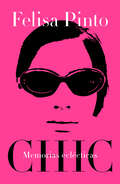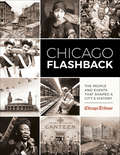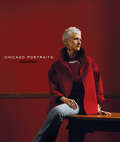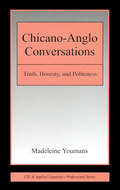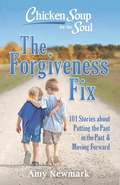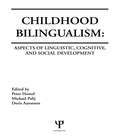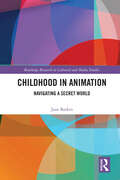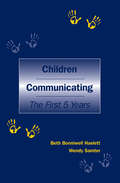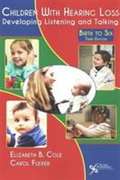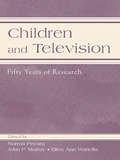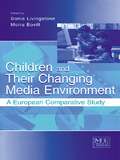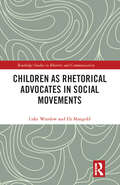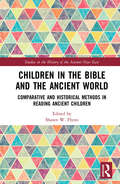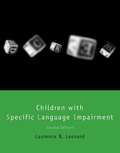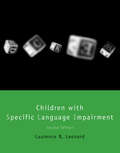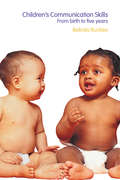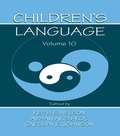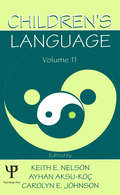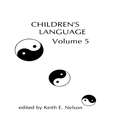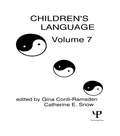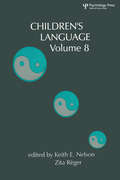- Table View
- List View
Chic: Memorias eclécticas
by Felisa Pinto«Espíritu libre, ¿intelectual, diletante? Europeizada, afrancesada, colonizada por el cine de Hollywood y el jazz, con ideas de avanzada, apartidista, activista de las buenas causas y del compromiso social. Mucho understatement, nomadismo, nonchalance. Hedonismo y austeridad a la vez. Ya entonces empecé a forjar una imagen que sería, con algunas variantes, la definitiva: despojada, sin adornos, pelo corto, modernista, inspirada en las mujeres de la Bauhaus.» «Influencer muchos años antes de que se acuñara el término, Felisa celebró desde sus crónicas y columnas las extravagancias, los estilos genuinos y las descripciones minuciosas y exquisitas. Estas memorias eruditas y elegantes son imprescindibles para entender los cruces de moda, cultura, música y vanguardias del siglo veinte».Victoria Lescano Fundadora de la crónica de moda en Argentina, retratista de la bohemia selecta del Buenos Aires de los 60 y 70, testigo irreverente de la evolución del gusto, forjadora de un estilo criollo de irradiación cosmopolita, musa y cómplice de una constelación de músicos, pintores, escritores, fotógrafos y diseñadores de varias generaciones, Felisa Pinto es el fruto de una vorágine de experiencias únicas. Hija de cruces providenciales con otras vidas, desarrolló una forma única de indagación de lo efímero en tiempo real de los usos y costumbres que fijaron la identidad visual de una época. Chic reúne recuerdos que son joyas y una selección de sus crónicas, en las que se despliega su poética del detalle aplicada con la misma gracia a personas reales como a texturas, colores y telas.
Chicago Flashback: The People and Events That Shaped a City's History
by Chicago TribuneThe history of America’s third-largest city, as told through stories and photos from the Chicago Tribune archives.The devoted journalists at the Chicago Tribune have been reporting the city’s news since 1847. As a result, the paper has amassed an inimitable, as-it-happened history of its hometown, a city first incorporated in 1837 that rapidly grew to become the third-largest in the United States. For the past decade, the Chicago Tribune has been mining its vast archive of photos and stories for its weekly feature Chicago Flashback, which deals with the significant people and events that have shaped the city’s history and culture from the paper’s founding to the present day, from the humorous to the horrible to the quirky to the remarkable.Now the editors of the Tribune have carefully collected the best, most interesting Chicago Flashback features into a single volume. Each story is accompanied by at least one black-and-white image from the paper’s fabled photo vault located deep below Michigan Avenue’s famed Tribune Tower. Chicago Flashback offers a unique, you-are-there perspective on the city’s long and colorful history.
Chicago Portraits
by Rick Kogan Chicago Tribune Staff Michael ZajakowskiThe Chicago Tribune possesses a vast photo archive spanning its more than 150 years in publication. From the Civil War era through today, its photographers have captured thousands of people, from everyday Chicagoans to visitors to the Second City to well-known artists, athletes, and politicians.For the first time, the best of these great photographic portraits are being collected in a large-format coffee-table edition. Chicago Portraits comprises the most memorable of the innumerable images that some of the greatest photographers in journalism have created over the past century. It's a unique showcase for the unsung photographers who've quietly documented daily life in Chicago, and through their decades of work created an unparalleled panorama of the City of Big Shoulders.Curated by the Tribune's photography directors and compiled in a beautiful sewn hardback edition, this will be an engrossing visual cross-section of Chicago life that will be pored over by readers young and old for years to come. Chicago Portraits is a fascinating and colorful look into the lives and legacies that make up this great American city.
Chicago by the Book: 101 Publications That Shaped the City and Its Image
by Neil Harris Caxton ClubDespite its rough-and-tumble image, Chicago has long been identified as a city where books take center stage. In fact, a volume by A. J. Liebling gave the Second City its nickname. Upton Sinclair’s The Jungle arose from the midwestern capital’s most infamous industry. The great Chicago Fire led to the founding of the Chicago Public Library. The city has fostered writers such as Nelson Algren, Saul Bellow, and Gwendolyn Brooks. Chicago’s literary magazines The Little Review and Poetry introduced the world to Eliot, Hemingway, Joyce, and Pound. The city’s robust commercial printing industry supported a flourishing culture of the book. With this beautifully produced collection, Chicago’s rich literary tradition finally gets its due. Chicago by the Book profiles 101 landmark publications about Chicago from the past 170 years that have helped define the city and its image. Each title—carefully selected by the Caxton Club, a venerable Chicago bibliophilic organization—is the focus of an illustrated essay by a leading scholar, writer, or bibliophile. Arranged chronologically to show the history of both the city and its books, the essays can be read in order from Mrs. John H. Kinzie’s 1844 Narrative of the Massacre of Chicago to Sara Paretsky’s 2015 crime novel Brush Back. Or one can dip in and out, savoring reflections on the arts, sports, crime, race relations, urban planning, politics, and even Mrs. O’Leary’s legendary cow. The selections do not shy from the underside of the city, recognizing that its grit and graft have as much a place in the written imagination as soaring odes and boosterism. As Neil Harris observes in his introduction, “Even when Chicagoans celebrate their hearth and home, they do so while acknowledging deep-seated flaws.” At the same time, this collection heartily reminds us all of what makes Chicago, as Norman Mailer called it, the “great American city.” With essays from, among others, Ira Berkow, Thomas Dyja, Ann Durkin Keating, Alex Kotlowitz, Toni Preckwinkle, Frank Rich, Don Share, Carl Smith, Regina Taylor, Garry Wills, and William Julius Wilson; and featuring works by Saul Bellow, Gwendolyn Brooks, Sandra Cisneros, Clarence Darrow, Erik Larson, David Mamet, Studs Terkel, Ida B. Wells-Barnett, Frank Lloyd Wright, and many more.
Chicano-Anglo Conversations: Truth, Honesty, and Politeness (ESL & Applied Linguistics Professional Series)
by Madeleine YoumansThis groundbreaking book--about differences in communication practices between Mexican-American underclass residents in an East Los Angeles housing project and white, middle-class literacy tutors who worked with them--makes an important contribution to research on the sociolinguistics of the Chicano gang culture. More specifically, this work adds substantially to research on understanding linguistic politeness theories, the use of epistemic modals for negative politeness, and evidentiality. It refines, and in a number of cases, defines, function categories for epistemic modals through a rigorous grammatical analysis. This book is also distinctive in that the author subjects the language of middle-class Anglos to the same type of scrutiny that is often reserved for non-mainstream groups. Youmans contends that the differences between the Chicano and Anglo speakers are the result of the two groups’ different sociocultural circumstances, including historical and current living and working patterns and the relative value placed on familialism and communalism versus individualism and independence. (The terms Chicano and Anglo are used as a kind of shorthand in this book--not to raise larger sociocultural issues implied by these terms.) Although the number of participants in the study limits the applicability of the findings as they might be extrapolated to all Chicanos/as, or all Anglos when reporting sociolinguistic observations, the main argument advanced is that language use may provide insights into beliefs, attitudes, and practices in the larger society. This volume is directed to researchers and graduate students in the areas of sociolinguistics, applied linguistics, discourse analysis, and cross-cultural communication, and will also interest language and linguistics educators and grammarians.
Chicken Soup for the Soul: The Forgiveness Fix
by Amy NewmarkLook beyond the hurt and use the power of forgiveness to move forward. Forgiveness is one of the best tools we have at our disposal to create a better life for ourselves. Leave that baggage behind as you put the past in the past— where it belongs!Forgiveness is an amazing tool—it can transform your life in just one second if you decide that you want to use its power. There&’s a reason we refer to anger, resentment, and disappointment as &“baggage.&” We carry it everywhere we go. We&’d like nothing more than to drop it on the side of the road and forget about it. But how do we do that? How do we process the past and then leave it behind? These 101 revealing true stories show you how. Learn how to manage your hurt with or without an apology and focus on what&’s really important. Read about marriages being strengthened, families getting back together, grown children coming to understand their parents, and people overcoming the worst transgressions—even crimes. These men and women walked forward light and free, and you can, too—onto the bright, warm, welcoming road ahead. And, because no one&’s perfect, you&’ll also learn how to apologize if you&’re the one in the wrong... and how to use the power of self-forgiveness to find peace and happiness.
Childhood Bilingualism: Aspects of Linguistic, Cognitive, and Social Development
by Doris Aaronson Peter Homel Michael PalijFirst published in 1987. This volume is based primarily on a conference on childhood bilingualism held at New York University on June 25 and 26, 1982 with an interest in exploring the nature of bilingual cognition and the effect of bilingualism on psychological development.
Childhood in Animation: Navigating a Secret World (Routledge Research in Cultural and Media Studies)
by Jane BatkinChildhood in Animation: Navigating a Secret World explores how children are viewed in animated cinema and television and examines the screen spaces that they occupy.The image of the child is often a site of conflict, one that has been captured, preserved, and recollected on screen; but what do these representations tell us about the animated child and how do they compare to their real counterparts? Is childhood simply a metaphor for innocence, or something far more complex that encompasses agency, performance, and othering? Childhood in Animation focuses on key screen characters, such as DJ, Norman, Lilo, the Lost Boys, Marji, Parvana, Bluey, Kirikou, Robyn, Mebh, Cartman and Bart, amongst others, to see how they are represented within worlds of fantasy, separation, horror, politics, and satire, as well as viewing childhood itself through a philosophical, sociological, and global lens. Ultimately, this book navigates the rabbit hole of the ‘elsewhere’ to reveal the secret space of childhood, where anything (and everything) is possible.This volume will be of great interest to scholars and students of animation, childhood studies, film and television studies, and psychology and sociology.
Children Communicating: The First 5 Years (Routledge Communication Ser.)
by Wendy Samter Beth Bonniwell HaslettOffering a unique focus on the development of human communication, this book integrates and synthesizes a more comprehensive array of research than most investigations of communicative development. As such, it incorporates materials dealing with the development of nonverbal communication, language, and cognition, and examines how they are integrated in the growing child's everyday interaction. This information is distilled into a set of key principles and practices--culled from a variety of fields including developmental and social psychology, sociolinguistics, psycholinguistics, and communication--for parents or adults interested in child development. While this book does not offer an in-depth view in any one area, it provides a comprehensive overview of the various components of human communicative development and its significance for the child's cognitive and emotional growth. It is quite clear that developmental processes are constrained by multiple influences whose interactions have just begun to be uncovered. Examining the diverse facets of communicative development will enable professionals to garner further insights into the mystery of human communication.
Children Tell Stories: Teaching and Using Storytelling in the Classroom
by Mitch Weiss Martha Hamilton Dede HatchThe revised edition of this award-winning guidebook on storytelling in the classroom includes over 80% new material. The authors provide compelling rationales for the value of storytelling, links to state literacy learning standards, detailed storytelling unit tips, easy ideas for storytelling throughout the curriculum, and carefully selected and extensive bibliographies. Considered the classic in the field, Children Tell Stories is useful to both experienced and novice teachers and storytellers who work with students from preschool through college.
Children With Hearing Loss: Developing Listening and Talking, Birth to Six (3rd Edition)
by Carol Flexer Elizabeth B. ColeThe third edition of Children With Hearing Loss: Developing Listening and Talking, Birth to Six provides updated information from the previous two editions for both professionals and parents facilitating spoken language through listening (auditory brain access, stimulation, and development) in infants and young children with hearing loss. Also addressed is auditory brain development, audiologic technologies, auditory skill development, spoken language development, as well as family-focused intervention for young children with hearing loss whose parents have chosen to have them learn to listen and talk.
Children and Television: Fifty Years of Research (Routledge Communication Series)
by Norma Pecora John P. Murray Ellen Ann WartellaThis seminal volume is a comprehensive review of the literature on children's television, covering fifty years of academic research on children and television. The work includes studies of content, effects, and policy, and offers research conducted by social scientists and cultural studies scholars. The research questions represented here consider the content of programming, children's responses to television, regulation concerning children's television policies, issues of advertising, and concerns about sex and race stereotyping, often voicing concerns that children's entertainment be held to a higher standard. The volume also offers essays by scholars who have been seeking answers to some of the most critical questions addressed by this research. It represents the interdisciplinary nature of research on children and television, and draws on many academic traditions, including communication studies, psychology, sociology, education, economics, and medicine. The full bibliography is included on CD.Arguably the most comprehensive bibliography of research on children and television, this work illustrates the ongoing evolution of scholarship in this area, and establishes how it informs or changes public policy, as well as defining its role in shaping a future agenda. The volume will be a required resource for scholars, researchers, and policy makers concerned with issues of children and television, media policy, media literacy and education, and family studies.
Children and Their Changing Media Environment: A European Comparative Study (Routledge Communication Series)
by Sonia Livingstone Moira BovillFocusing on the meanings, uses, and impacts of new media in childhood, family life, peer culture, and the relation between home and school, this volume sets out to address many of the questions, fears, and hopes regarding the changing place of media in the lives of today's children and young people. The scholars contributing to this work argue that such questions--intellectual, empirical, and policy-related--can be productively addressed through cross-national research. Hence, this volume brings together researchers from 12 countries--Belgium, Denmark, Finland, France, Germany, the United Kingdom, Israel, Italy, the Netherlands, Spain, Sweden, and Switzerland--to present original and comprehensive findings regarding the diffusion and significance of new media and information technologies among children. Inspired by parallels and difference between the arrival of television in the family home during the 1950s and the present day arrival of new media, the research is based on in-depth interviews and a detailed comparative survey of 6- to 16-year-olds across Europe and in Israel. The result is a comprehensive, detailed, and fascinating account of how these technologies are rapidly becoming central to the daily lives of young people. As a resource for researchers and students in media and communication studies, leisure and cultural studies, social psychology, and related areas, this volume provides crucial insights into the role of media in the lives of children. The findings included herein will also be of interest to policymakers in broadcasting, technology, and education throughout the world.
Children as Rhetorical Advocates in Social Movements (Routledge Studies in Rhetoric and Communication)
by Luke Winslow Eli MangoldThis book examines “Rhetorical Children” as visible and vocal communicators, shaping public discourse on contentious social issues related to organized labor, civil rights, gun violence, and climate change. This book explores four key social movement case studies: the 1903 Mother Jones-led March of the Mill Children to reform child labor laws, the 1963 Dr. Martin Luther King, Jr.,-led Children’s Crusade to end segregation, the 2018 Parkland student-led March for Our Lives movement to end gun violence, and the ongoing struggle for climate change mitigation led by Swedish activist Greta Thunberg. Through these case studies, the book outlines three rhetorical strategies, namely children’s ability to activate adults’ moral obligation; to invoke threats to natality and lost childhood; and to disrupt social order. It enables readers to better understand rhetorical children and the rhetorical tools required for social movements. Assessing the powerful role children play in shaping public discourse, this book will be of interest to students and scholars in the fields of Communication Studies, Rhetoric, Public Address, Social Movements, and Cultural Studies.
Children in the Bible and the Ancient World: Comparative and Historical Methods in Reading Ancient Children (Studies in the History of the Ancient Near East)
by Shawn FlynnThe topic of children in the Bible has long been under-represented, but this has recently changed with the development of childhood studies in broader fields, and the work of several dedicated scholars. While many reading methods are employed in this emerging field, comparative work with children in the ancient world has been an important tool to understand the function of children in biblical texts. Children in the Bible and the Ancient World broadly introduces children in the ancient world, and specifically children in the Bible. It brings together an international group of experts who help readers understand how children are constructed in biblical literature across three broad areas: children in the Hebrew Bible and the Ancient Near East, children in Christian writings and the Greco-Roman world, and children and materiality. The diverse essays cover topics such as: vows in Ugarit and the Hebrew Bible, obstetric knowledge, infant abandonment, the role of marriage, Greek abandonment texts, ritual entry for children into Christian communities, education, sexual abuse, and the role of archeological figurines in children’s lives. The volume also includes expertise in biological anthropology to study the skeletal remains of ancient children, as well as how ancient texts illuminate Mary’s female maturity. The volume is written in an accessible style suitable for non-specialists, and it is equipped with a helpful resource bibliography that organizes select secondary sources from these essays into meaningful categories for further study. Children in the Bible and the Ancient World is a helpful introduction to any who study children and childhood in the ancient world. In addition, the volume will be of interest to experts who are engaged in historical approaches to biblical studies, while appreciating how the ancient world continues to illuminate select topics in biblical texts.
Children with Specific Language Impairment
by Laurence B. LeonardChildren with specific language impairment (SLI) show a significant deficit in spoken language that cannot be attributed to neurological damage, hearing impairment, or intellectual disability. More prevalent than autism and at least as prevalent as dyslexia, SLI affects approximately seven percent of all children; it is longstanding, with adverse effects on academic, social, and (eventually) economic standing. The first edition of this work established Children with Specific Language Impairment as the landmark reference on this condition, considering not only the disorder's history, possible origins, and treatment but also what SLI might tell us about language organization and development in general. This second edition offers a complete update of the earlier volume. Much of the second edition is completely new, reflecting findings and interpretations based on the hundreds of studies that have appeared since the publication of the first edition in 1997. Topics include linguistic details (descriptive and theoretical), word and sentence processing findings, genetics, neurobiology, treatment, and comparisons to such conditions as autism spectrum disorders, ADHD, and dyslexia. The book covers SLI in children who speak a wide range of languages, and, although the emphasis is on children, it also includes studies of adults who were diagnosed with SLI as children or are the parents of children with SLI. Written by a leading scholar in the field, Children with Specific Language Impairment offers the most comprehensive, balanced, and unified treatment of SLI available.
Children with Specific Language Impairment (Language, Speech, and Communication)
by Laurence B. LeonardThe landmark reference in the field, completely updated: a comprehensive treatment of a disorder that is more prevalent than autism. Children with specific language impairment (SLI) show a significant deficit in spoken language that cannot be attributed to neurological damage, hearing impairment, or intellectual disability. More prevalent than autism and at least as prevalent as dyslexia, SLI affects approximately seven percent of all children; it is longstanding, with adverse effects on academic, social, and (eventually) economic standing. The first edition of this work established Children with Specific Language Impairment as the landmark reference on this condition, considering not only the disorder's history, possible origins, and treatment but also what SLI might tell us about language organization and development in general. This second edition offers a complete update of the earlier volume.Much of the second edition is completely new, reflecting findings and interpretations based on the hundreds of studies that have appeared since the publication of the first edition in 1997. Topics include linguistic details (descriptive and theoretical), word and sentence processing findings, genetics, neurobiology, treatment, and comparisons to such conditions as autism spectrum disorders, ADHD, and dyslexia. The book covers SLI in children who speak a wide range of languages, and, although the emphasis is on children, it also includes studies of adults who were diagnosed with SLI as children or are the parents of children with SLI.Written by a leading scholar in the field, Children with Specific Language Impairment offers the most comprehensive, balanced, and unified treatment of SLI available.
Children's Communication Skills: From Birth to Five Years
by Belinda BuckleyBased on a huge body of research in child language and communication development, Children's Communication Skills uses a clear format to set out the key stages of communication development in babies and young children. Its aim is to increase awareness in professionals working with children of what constitutes human communication and what communication skills to expect at any given stage. Illustrated throughout with real-life examples, this informative text addresses: normal development of verbal and non-verbal communication skills the importance of play in developing these skills developmental communication problems bilingualism, cognition and early literacy development working with parents of children with communication difficulties. Features designed to make the book an easy source of reference include chapter summaries, age-specific skills tables, sections on warning signs that further help may be needed, and a glossary of key terms. It will be of great use to a wide range of professionals in training or working in health, education and social care.
Children's Language: Volume 10: Developing Narrative and Discourse Competence (Children's Language Ser.)
by Ayhan Aksu-Koç Keith E. Nelson Carolyn E. JohnsonThese volumes present coherent sets of papers developed along two of the thematic lines that underscored the program of the meeting of the International Association for the Study of Child Language in Istanbul in the summer of 1996. Thoroughly reviewed and updated to reflect the state of child language research and theory--particularly in the domains of discourse and interaction--they convey not only the flavor of that meeting but some of the most exciting trends in the field today. Each contribution in Volume 10, Developing Narrative and Discourse Competence, focuses on the differential effects of discourse genres, elicitation techniques, communicative contexts, literacy and schooling, and the oft-cited variables of age, language, and culture. Issues concerning the interrelations between social, cognitive, and affective capacities and processes in discourse are addressed. Each chapter raises theoretical questions regarding how and when representations are constructed to support new complexities. Presenting data from a cross-cultural and cross-linguistic perspective, this volume highlights both the particulars and the universals of the processes involved. The chapters in Volume 11, Interactional Contributions to Language Development, address issues including scaffolding of processing and learning in particular interactional sequences; linkages among interpersonal functions or relations, cognitive development, and semantic, syntactic, and pragmatic devices or forms; and models of how interactions proceed, input is selected, and learning advances across multiple rounds of interaction. Each of these volumes will be a valuable addition to the libraries of all who study the development of language.
Children's Language: Volume 11: Interactional Contributions To Language Development (Children's Language Ser.)
by Ayhan Aksu-Koç Keith E. Nelson Carolyn E. JohnsonThese volumes present coherent sets of papers developed along two of the thematic lines that underscored the program of the meeting of the International Association for the Study of Child Language in Istanbul in the summer of 1996. Thoroughly reviewed and updated to reflect the state of child language research and theory--particularly in the domains of discourse and interaction--they convey not only the flavor of that meeting but some of the most exciting trends in the field today. Each contribution in Volume 10,Developing Narrative and Discourse Competence, focuses on the differential effects of discourse genres, elicitation techniques, communicative contexts, literacy and schooling, and the oft-cited variables of age, language, and culture. Issues concerning the interrelations between social, cognitive, and affective capacities and processes in discourse are addressed. Each chapter raises theoretical questions regarding how and when representations are constructed to support new complexities. Presenting data from a cross-cultural and cross-linguistic perspective, this volume highlights both the particulars and the universals of the processes involved. The chapters in Volume 11, Interactional Contributions to Language Development, address issues including scaffolding of processing and learning in particular interactional sequences; linkages among interpersonal functions or relations, cognitive development, and semantic, syntactic, and pragmatic devices or forms; and models of how interactions proceed, input is selected, and learning advances across multiple rounds of interaction. Each of these volumes will be a valuable addition to the libraries of all who study the development of language.
Children's Language: Volume 4 (Children's Language Series)
by Keith E. NelsonFirst published in 1983. This series, Children’s Language, reflects the conviction that extensive work on entirely new fronts along with a great deal of reinterpretation of old-front data will be necessary before any persuasive and truly orderly account of language. For all volumes in the series there is a common scheme of operation with two tactics. First, to give authors sufficient planning time and freedom to arrive at a chapter-length account of their area of thinking which vividly shows both the progress and the problems in that area, with the author of each chapter free to find a workable proportion of new experimental contributions, review, and theory. The second tactic concerns the selection of topics for each volume. This is Volume 4. Structures about language and thought and children as employed in certain other fields may well be shaken and stimulated, particularly in education, sociology, anthropology, literature, and language remediation.
Children's Language: Volume 5 (Children's Language Series)
by Keith E. NelsonFirst published in 1985. In children’s language we are in search of the “ great bears,” the clear solid patterns that hold up after countless angles of view and after many, many lenses have been tried. In the first four volumes of this series, Children's Language, there has been coverage of alternative theories and methods in syntax, semantics, discourse, phonology, figurative language, second language learning, the transition to text processing, and story structures, among other topics. In order to present a lively account of development, the authors in the first four volumes were encouraged to each adopt a flexible format—one that best fit their own material rather than sticking to a standard review organization. Exactly the same approach has been taken by the authors of the present volume 5.
Children's Language: Volume 6 (Children's Language Series)
by Keith E. Nelson; Anne van KleeckThis series, Children’s Language, reflects the conviction that extensive work on entirely new fronts along with a great deal of reinterpretation of old-front data will be necessary before any persuasive and truly orderly account of language development can be assembled. None of the chapters are simply reviews, and none of the volumes are " handbooks" or " reviews" or introductory texts. Rather the volumes try to capture the excitement and complexity of thinking and research at the growing, advancing edges of this broad field of children’s language. In line with these goals for the Children’s Language series the present volume includes coverage of a fairly wide range of topics and subtopics. The authors for each chapter will weave their own story and we leave to them the introduction of their main plots and the major and minor characters in their scientific stories. This is volume 6.
Children's Language: Volume 7 (Children's Language Series)
by Catherine E. Snow Gina Conti-RamsdenThis volume presents current research findings on vital issues in language development compiled by an international group of leading researchers. The data are drawn from studies of the acquisition of Swedish, Polish, Serbo-Croatian, Hungarian, Portuguese, Italian, and English. Themes emphasized in all the chapters include the importance of the social context of acquisition, the existence of interconnections among various domains of language development, and the impossibility of understanding acquisition using a simple theory or a single methodological approach.
Children's Language: Volume 8 (Children's Language Series)
by Keith E. Nelson Zita RégerEach child is spoken to by genetic heritage and by the rich current set of interactional environments -- familial, local community, and broader cultural voices. Using past structures and paradigms of scholarship, scholars seek to understand what the child achieves in language and how. The tools available for this research are not static but evolve jointly through the sharing of information, and with each "brief moment in time" in efforts to look at children's languages "just as they are." Containing a wide range of contributions from developmental approaches to phonological ability, the lexicon, the grammar as well as conversation and sign language, this text details the interrelated research and theorizing discussed at a recent Budapest conference. The meeting of the International Association for the Study of Child Languages was particularly rich in the diversity of scholars present, which is highly appropriate because such diversity is integral to an informed study of children's language.
